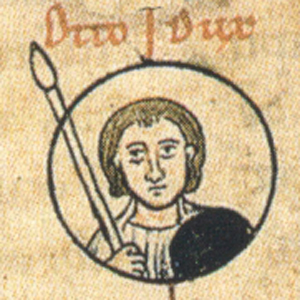Otto (c. 830/835/51 – 30 November 912), called the Illustrious (German: Otto der Erlauchte) by later authors, was a notable member of the Ottonian dynasty and Duke of Saxony from 880 until his death in 912. He played an important role in early medieval history of Germany during the 9th and 10th centuries, known for his military campaigns and diplomatic efforts.
Otto the Illustrious | |
|---|---|
| Duke of Saxony | |
 Depiction of Otto I Dux, in the Chronica Sancti Pantaleonis, Cologne (c. 1237) | |
| Reign | 880 - 912 |
| Predecessor | Bruno, Duke of Saxony |
| Successor | Henry the Fowler |
| Born | c. 830/51 Saxony, Germany |
| Died | 30 November 912 Wallhausen, Saxony |
| Buried | Gandersheim Abbey |
| Noble family | Ottonian dynasty |
| Spouse(s) | Hathui of Babenberg |
| Issue | Thankmar Liudolf Henry the Fowler Oda of Saxony |
| Father | Liudolf, Duke of Saxony |
| Mother | Oda |
Family
Otto was the younger son of the Saxon count Liudolf (d. 866), the progenitor of the dynasty, and his wife Oda (d. 913),[1] daughter of the Saxon princeps Billung. Among his siblings were his eldest brother Bruno, heir to their father's estates, and Liutgard, who in 876 became Queen of East Francia as consort of the Carolingian king Louis the Younger. The marriage expressed Liudolf's dominant position in the Saxon lands.
Around 873 Otto himself married Hathui (d. 903),[1] probably daughter of the Frankish princeps militiae Henry of Franconia, a member of the noble House of Babenberg (Popponids). By her he had two sons, Thankmar and Liudolf, who predeceased him, but his third son Henry the Fowler succeeded him as duke of Saxony and was later elected king of East Francia.[1] Otto's daughter Oda married the Carolingian King Zwentibold of Lotharingia,[1] son of Emperor Arnulf.
His family came to be known as the Liudolfinger after his father, Liudolf. Upon the accession of his grandson, Emperor Otto the Great, the dynasty came to be referred to as the Ottonian dynasty.
Reign
On 26 January 877, King Louis the Younger issued a charter to Gandersheim Abbey. The charter described the region of South Thuringia, known as ‘pago Suththuringa,’ as ‘in comitatu Ottonis,’ which means 'in Otto's country.' He succeeded his brother Bruno as duke of Saxony after the latter's death in the Battle of Lüneburg Heath (Ebsdorf) on 2 February 880, while fighting against the Viking invaders.[2]
Ruling over vast Saxon and Thuringian estates, Otto was mentioned as dux in later sources, while in a contemporary charter of 28 January 897, Otto is described as marchio and the pago Eichesfelden (Eichsfeld) is now found to be within his county (march). He was also the lay abbot of Hersfeld Abbey in 908[3] and fifty years later was described as magni ducis Oddonis (great duke Otto) by the chronicler Widukind of Corvey when describing the marriage of his sister Liutgard to King Louis.
Despite his dynastic relations, Otto only had loose connections to the Carolingian court and rarely left Saxony. He remained a regional East Frankish prince and his lieges, Louis the Younger and Emperor Arnulf, with both of whom he was on good terms, rarely interfered in Saxon autonomy. In his lands, Otto was prince in practice and he also established himself as a tributary ruler over the neighbouring Slavic tribes in the east, such as the Daleminzi.
According to Widukind of Corvey, the "Saxon and Franconian people" offered Otto the kingship of East Francia after the death of the last Carolingian monarch, Louis the Child, in 911. Otto did not accept the offer, possibly because he felt the burden of ruling was too heavy for him at his advanced age.[4] Instead, suggesting Duke Conrad of Franconia. The truthfulness of this report is considered doubtful.[lower-alpha 1]
The next year, in 912, Otto died at the Pfalz of Wallhausen. He was buried in the church of Gandersheim Abbey.
Notes
- Reuter calls it "panegryric rather than history."[5]
References
Sources
Wikiwand in your browser!
Seamless Wikipedia browsing. On steroids.
Every time you click a link to Wikipedia, Wiktionary or Wikiquote in your browser's search results, it will show the modern Wikiwand interface.
Wikiwand extension is a five stars, simple, with minimum permission required to keep your browsing private, safe and transparent.
